Fractal Design Define R3: A Fan Favorite Keeps the Noise Down
by Dustin Sklavos on November 11, 2011 1:22 AM EST- Posted in
- Cases/Cooling/PSUs
- mid-tower
- Fractal Design
Noise and Thermal Testing, Overclocked
While I'm certain the R3 could handle our overclocked testbed with aplomb if its cooling system were modified, its stock configuration, geared more towards silence, does make things a bit more complicated. Still, modification to the cooling is an allowance Fractal Design offers that the NZXT H2 and to a lesser extent the Antec Solo II have trouble competing with.
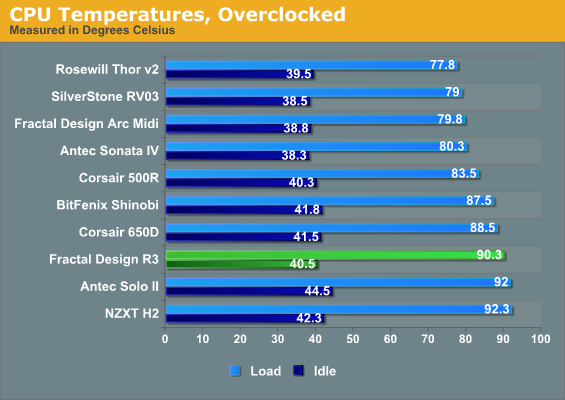

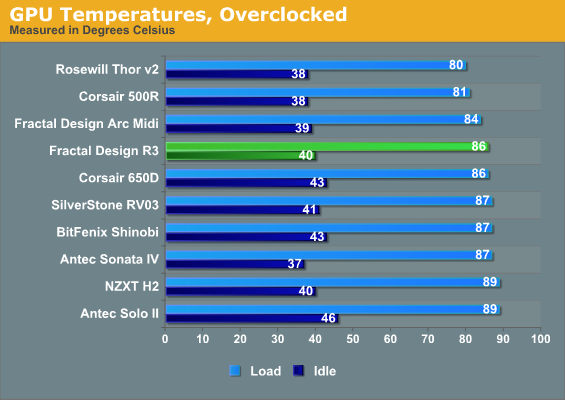
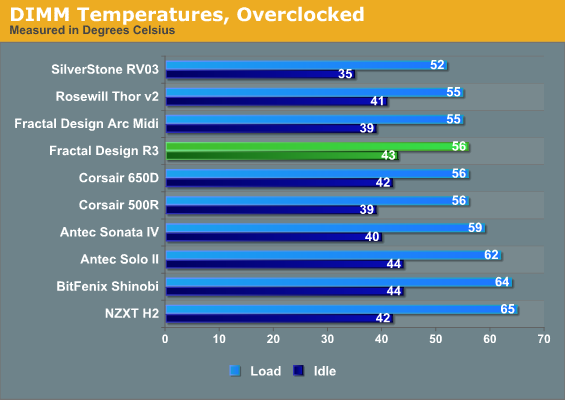
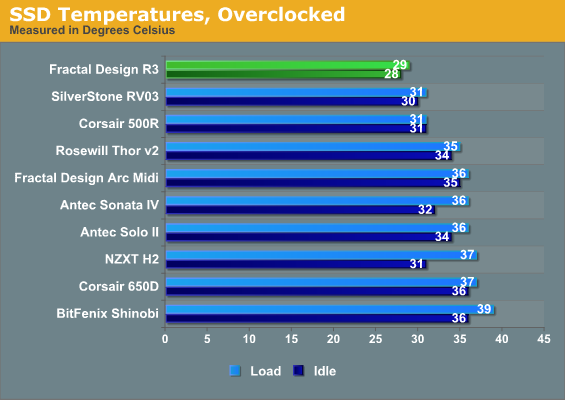
CPU thermals are pretty poor and at least a little troubling (nobody wants to see cores running north of 90C), but again, the middle-of-the-road thermal performance elsewhere is justified by the silent running. A key point worth noticing, too, is the SSD temperatures recorded: the SSD is sitting behind an intake fan, and it's pretty clear that the R3 is able to pull in plenty of cool outside air through the ventilation in the sides of the front panel. Fractal Design dodged the bullet that mortally wounded NZXT's H2. I suspect a pair of SilverStone AP120s would go a long way towards improving thermals while still keeping a pretty quiet noise profile.
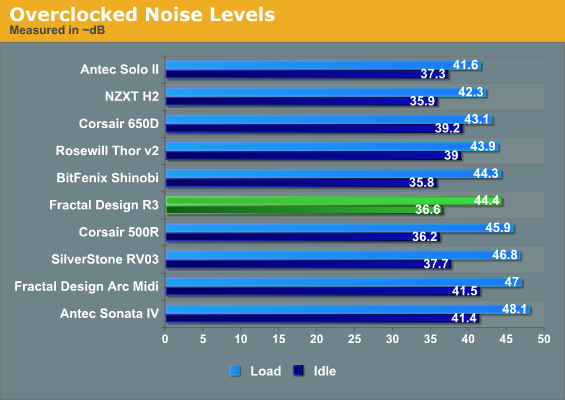
Unfortunately, while the R3's able to keep things quiet at idle, under load the case and CPU fans have to work overtime and the Solo II and H2 steal the lead. Still, performance isn't necessarily that bad here and again, the R3 has room to grow.










83 Comments
View All Comments
Peskarik - Saturday, November 12, 2011 - link
Define R3 is an older design, that was what Fractal told answered me when I mentioned the fixed drive cage, which I as well find to be a nuisance.Coup27 - Friday, November 11, 2011 - link
For someone who hasn't kept pace with case designs for a long time, could somebody please explain why the PSU now goes at the bottom instead of the top?jrs77 - Friday, November 11, 2011 - link
The PSU sits in the bottom to make it easier to cool and less noisy. Usually PSUs have a thermal-controlled fan, which then runs faster, if it sucks hot air from within the case. That's why they get mounted on the bottom, where they can suck in fresh air instead, running cooler and more silent. Also, this setup allows for fans being mounted in the top as additional cooling for the CPU, etc.BTT:
The trick with the cable-routing is to rout the cables prior to installing the motherboard, then they'll fit through the grommets easily enough.
Well, and for cooling and noise... using better and more fans (Scythe S-Flex SFF21D) to drop both, temps and noise-levels does help.
The biggest plus for the Define R3 is the understatement and the sounddampening at a very low price.
The allways mentioned CM Silencio doesn't have the top-fan-mounts, which are pretty good for installing a 240mm rad.
piroroadkill - Friday, November 25, 2011 - link
For one thing, it is becoming a heavier and heavier component with increasing power needs, and I don't think 4 screws at the back and just leaving it hanging is a great idea. With it at the top you'd end up with a big shelf splitting up the case to hold it, otherwise.Bottom is actually pretty good, and it means you don't have a big mains cable trailing across the back of all your other cables round the back of your machine.
Casper42 - Friday, November 11, 2011 - link
When will some half way decent Case Mfg eventually realize that when moving the PSU to the bottom, you should really move the Optical bays as well. It doesn't seem that bad in this case because its limited to 2 Optical bays, but every other case with a bottom PSU and 3 / 4 optical bays means that after installing a nice large GPU, you effectively have created a wall between the Fans pushing cool air in at the bottom and the CPU which is now way up at the top of the case.The Cooler Master Silencio 550 that someone in the comments mentioned is a PERFECT example of this.
http://www.guru3d.com/article/cooler-master-silenc...
Look at the side shot with the video card.
So that tiny slit above the right side of the video card and a whopping 1" gap between the video card and the side panel is where your CPU gets its cool air from?
Move the damn Optical bays to the bottom so they line up with the PSU (ideally only 2 bays like the R3) and now you have 2 x 120 or 2 x 140 pushing cool air in the front that line up perfectly with the components that need the best cooling. Upper fan cools the RAM and CPU and the lower fan cools the GPU(s).
JonnyDough - Friday, November 11, 2011 - link
and thought it might benefit you, the world.http://video.pbs.org/video/1050932219
Please watch this video on PBS. It is, needless to say - quite interesting, particularly if you are not familiar with fractals.
Gnarr - Saturday, November 12, 2011 - link
Thanks for a great article :)I however want to point out that "Methodology" is the study of methods, so unless page 4 is supposed to be teaching us the methods of testing, instead of telling us what methods were used for testing, it should be called "Testing methods", not "Testing Methodology" :)
JonnyDough - Saturday, November 12, 2011 - link
Its no secret that the tech sites I read need better editors. Good catch. :DJarredWalton - Saturday, November 12, 2011 - link
Nope. Methodology: http://www.thefreedictionary.com/methodologyOnly 1b suggests methodology as the study of methods. 1a and 3 both support the use of the phrase "Testing Methodology", though "Testing Methods" is equally acceptable.
Death666Angel - Saturday, November 12, 2011 - link
I don't really see anything special here.Since you mentioned the foam, can you make a an article about foam and how it effects temperatures and noise, if at all? I think the best you can do if you want a quiet PC is choose cool running, quiet hardware. A case does not make or break a silent/cool PC. Of course, that doesn't mean cases are unimportant, they can screw some things up if they are badly designed. But mostly, it's the components inside the case that should be of concern.